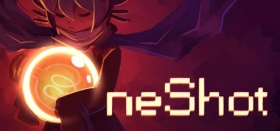
OneShot Review
A child wakes up in a dark world that is not her own and finds a lightbulb. Within the first few minutes of play, you are told that your actions will have consequences, and that you only have one shot at saving the world.

OneShot is an indie puzzle adventure game that originally released back in 2014; it’s only with the recent Steam release that I’ve had the pleasure, though, and I’m bloody glad I have. The easiest comparison to make here is with last year’s Undertale, and for many people that should be argument enough for you to stop reading and go play. The narrative is the main focus here, with a much greater emphasis being placed on the player’s relationship with the protagonist. As promised, your actions have consequences for her both inside and outside of the game window, and I found those first few minutes of gameplay to be incredibly tense in spite of a lack of combat. My mistakes could very well ruin my chances at finishing this one, and then how would I write a review?
Although OneShot can be completed in very little time, its world is densely packed with item puzzles and interactable characters; it will very much feel as though you are missing whole chunks of world building or character development until you relentlessly scour every area at least once. The game is steeped in mystery from the off, and this atmosphere permeated my entire experience. After all, if I failed to talk to a specific hidden character, or couldn’t find a vital item, would I fail and condemn this world to ruin? Similarly, the use of silences and darkness effectively created a suspense that made pushing on as anxiety-inducing as it was exciting.

One of the key criticisms that Undertale had was related to the visual design and the mediocre quality of its pixel art; that, thankfully, is not shared by OneShot, with characters and environments looking crisp and well defined. This goes a long way to enhancing the relationship between Niko and the player, owing to her actually looking like a kitten and not a collection of ambiguously-placed squares. This is true of all characters in the game, and with the focus on surreality becoming more and more prominent in the latter chapters, it’s nice to be able to kind of identify what that man has in place of a head. As the player reaches different milestones throughout the game, they’ll be treated to some stunning watercolour artwork within a dream sequence, or a slow pan over the area they are about to explore. These areas become more impressive in their scale as the game reaches its climax, and it feels really special to be exploring them for the first time with Niko, who also does not belong. Unfortunately, the soundtrack didn’t have quite the same effect on me; yes, there were a few okay pieces in there, but the rest of it felt far less memorable, and there was no one track I can really say stood out.
My main criticism is not with the game, but with how the Steam version handles itself. In the original, closing the game window manually would straight up kill the protagonist, and once you had finished (or failed) the game, there were no second chances to play. Granted, there are hints that this theme remains; however, closing the game merely saves, and finding ways to replay the adventure isn’t nearly as complicated as before. Don’t get me wrong, if I had spent money on a game that refused to let me play it I would be livid, but from an artistic perspective the experience feels hollowed out and somewhat less meaningful. What really baffles me is that, when I did figure out how to start from the beginning, I found some very subtle differences that threw further mystery upon the narrative: if I only had one shot, why do you want me to keep coming back?

There isn’t really that much more to say. Well, there is – I could sit here gushing for another half hour, but this is one of those games that is best experienced first-hand with a blind playthrough. It has a certain intelligence to its puzzles and story that brought a smile to my face as I figured out its tricks. It doesn’t hold your hand, and it doesn’t hold back, making that first experience so much more distinct. To be honest, I’m really disappointed that this release doesn’t impose the same “one shot” challenge on the player as the original copy did, but that really is my only complaint. Of course, it’s no masterpiece, but it wouldn’t have much further to go, and I feel so much the better for having been exposed to this gem.
OneShot (Reviewed on Windows)
This game is great, with minimal or no negatives.
It’s short, but worth every second of your time. This version is somewhat more forgiving than the original, much to my disappointment, but the visuals, atmosphere and narrative come together to create a particularly impressive experience.






COMMENTS